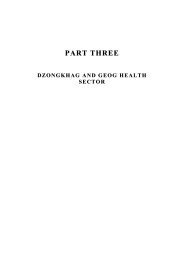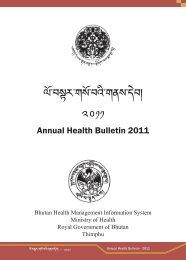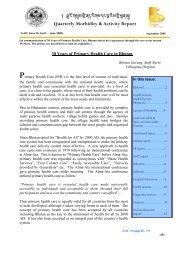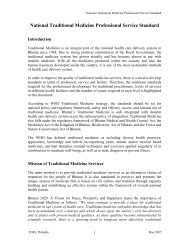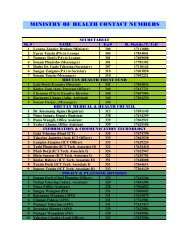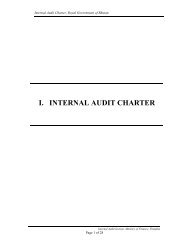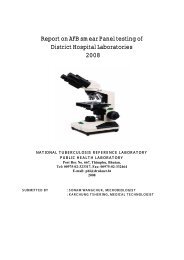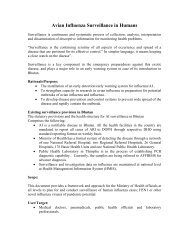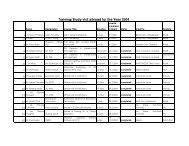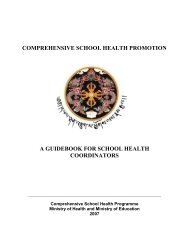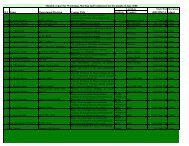ANNUAL HEALTH BULLETIN 2004 - Ministry of Health
ANNUAL HEALTH BULLETIN 2004 - Ministry of Health
ANNUAL HEALTH BULLETIN 2004 - Ministry of Health
Create successful ePaper yourself
Turn your PDF publications into a flip-book with our unique Google optimized e-Paper software.
• EPI mid level management training was conducted for DMOs/DHSOs and primary<br />
health workers from 2003 and on going activities.<br />
• No. Cases <strong>of</strong>MNT have been reported since 1994.<br />
AFP Surveillance:<br />
• Bhutan is a non-endemic country for poliomyelitis. The last case <strong>of</strong> clinically<br />
compatible case <strong>of</strong> poliomyelitis was detected in 1986 in Tsirang Dzongkhag. But<br />
due to its porous border with an endemic country, India, the risk <strong>of</strong> importation <strong>of</strong><br />
poliovirus is always there. Thus, in order to control measures, acute flaccid paralysis<br />
(AFP) surveillance was initiated in later part <strong>of</strong> 1997.<br />
• Since, 1997, 18 <strong>of</strong> AFP cases were reported and investigated and discard as nonpolio<br />
by the national expert committee polio eradication.<br />
During 2003 4 AFP cases was reported and active surveillance pick up one unreported<br />
case <strong>of</strong> AFP from JDWNRH, Thimphu and stool result was inadequate because <strong>of</strong> late<br />
collection and that case was referred to Kolkota for the further treatment. Now the case<br />
has been investigated and discards as non-polio by the national expert committee.<br />
Rubella.<br />
Rubella was not a notifiable disease in the country. The new as well as the old hospital<br />
and BHU reporting forms did not include rubella for routine reporting. No. Laboratory<br />
testing facilities for rubella existed prior to April 2003. Though clinical suspicion <strong>of</strong><br />
rubella was made; there were no supportive diagnostic facilities.<br />
Trongsa had an outbreak <strong>of</strong> febrile rash in 2003. This occurred in the municipality areas<br />
as well as in some nearby villages. A total <strong>of</strong> five schools had the outbreak which had<br />
laboratory confirmed rubella. There were six other Dzongkhags that reported similar<br />
epidemics these were laboratory confirmed as rubella epidemic. In 2003 Public <strong>Health</strong><br />
Laboratory has received 179 sample <strong>of</strong> blood for analysis among which 35 samples<br />
tested were from pregnant women from the outbreak area in Trongsa. All were negative<br />
for rubella (IgM). These samples were tested for anti-measles IgM as well as antirubella<br />
IgM.All the samples were negative for measles IgM. Fifty-five samples tested<br />
positive for Rubella IgM among non-pregnant groups.



